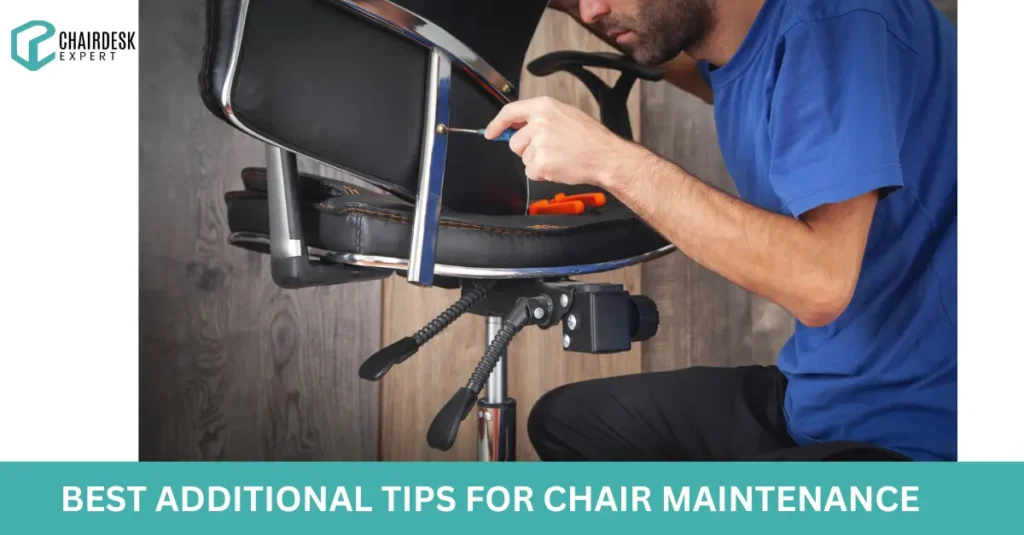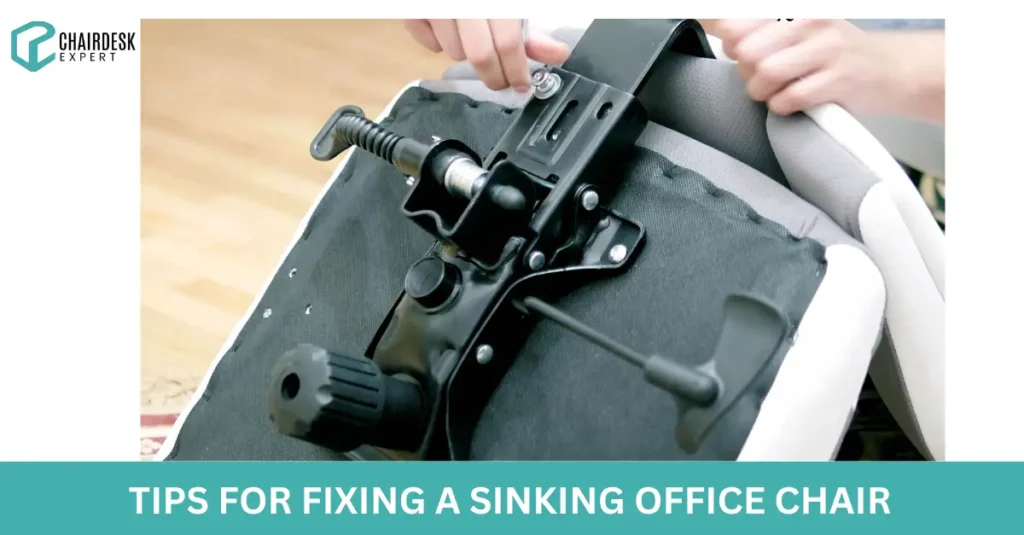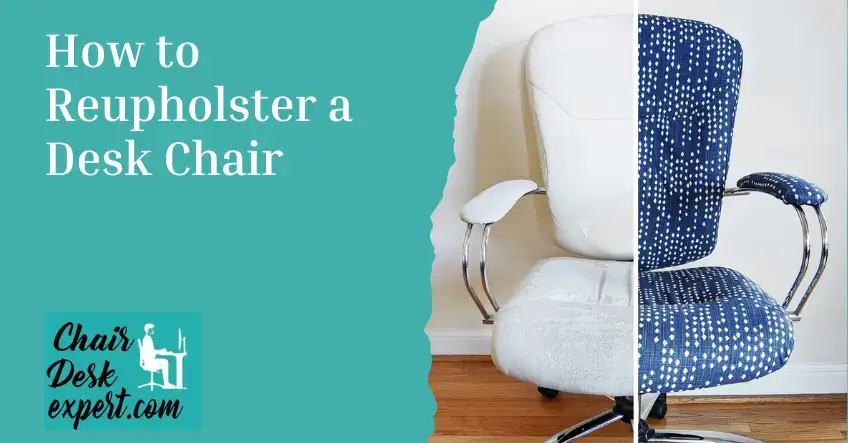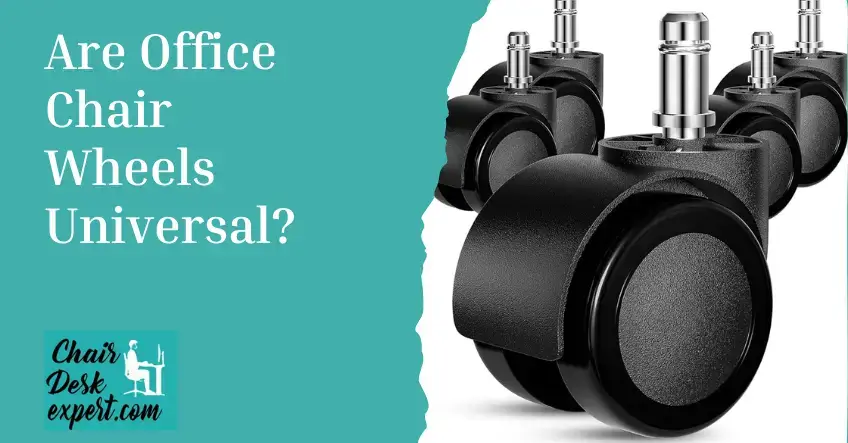Do you have an unstable chair either at home or in the office? It’s crucial to address this issue to prevent any potential accidents.Here’s a simple guide on. How to fix a wobbly office chair and restore your chair to its full functionality.
What is a Wobbly Office Chair?
A wobbly office chair feels slightly unstable, and shakes, or rocks while sitting. It can either sway sideways or front to back. This is possible when parts like screws, bolts, or casters become loose. Such a chair not only provides discomfort but also makes sitting unsafe.
Fixing the wobbly office chair requires tightening all the loose screws or replacing the damaged parts. You will have to check the base, seat, and wheels for damages. Once it is repaired, the chair will be steady enough to be safe for use again. Very simple steps are involved in the solution.
How to fix a wobbly office chair (Detailed Guide)
Do you have a wobbly desk chair, making it hard to work comfortably? No worries. How to fix a wobbly office chair requires a few simple steps you can fix quickly. First, tighten screws and check for consistent tightness. If that doesn’t work, replace damaged or worn-out components such as the chair’s structure, arms, or castors. Your chair will be steady and sturdy in no time!
This guide will explain in detail How to fix a wobbly chair. Let’s start to disclose.
What Are the Most Common Causes of a Wobbly Chair?
These are some common reasons behind wobbly chairs check it out then we will discuss How you can fix wobbly office chair easily.
- Worn Joints
- Broken Parts
- Missing Screws
- Age
- Poor Manufacturing
Worn Joints:
Prolonged sitting places stress on the chair’s joints, leading them to lose strength over time. If a joint becomes worn out, it can result in imbalance and wobbliness.
Broken Parts:
Parts of the chair, particularly wheels, may get damaged or broken due to age or external factors. A malfunctioning wheel can contribute to chair instability.
Missing Screws:
Although less common, loose or missing screws over time can lead to instability. If screws fall out, the chair may wobble, posing a safety risk for those seated in it.
Age:
The aging of chair components is a primary factor in wobbliness. Even with careful treatment, certain parts may wear down over time, necessitating the replacement of the chair or its components.
Poor Manufacturing:
Chairs made with low-quality materials may wear down faster than those constructed with higher quality standards. Opting for a well-manufactured and durable office chair can help prevent premature wear and instability issues.
How to fix a wobbly office chair Steps to Follow

If your office chair is wobbling, follow these quick instructions on how to address the issue. Here’s a step-by-step guide on How to fix a wobbly office chair.
Materials Needed:
- Drill
- Hammer
- Sandpaper
- Coping Saw (For wooden chairs)
- Wood Glue
- Strap Clamp
- Rag
- Replacement Pieces (if required)
Step One – Label Each Chair Part:
If you’re unfamiliar with chair assembly, label each part to aid in reassembly later.
Step Two – Disassemble the Chair Carefully:
Use tools like a drill and hammer to disassemble the chair. Take care not to lose any screws or small pieces during this process.
Step Three – Check for Missing Pieces:
Inspect for any missing components like screws or joints and make a note for replacement.
Step Four – Clean Dirty Pieces:
Thoroughly clean any dirty components with a rag to ensure they’re debris-free.
Step Five – Replace Broken Parts:
If any parts are broken, set them aside and find suitable replacements.
Step Six – Apply Wood Glue to Joints:
Coat the joints with high-quality wood glue. Reassemble each joint carefully to match their original configuration.
Step Seven – Tighten with a Strap Clamp:
Use a strap clamp or rope to securely tighten the chair’s body. Avoid excessive pressure that could lead to breakage.
Step Eight – Allow Glue to Set:
Wait at least a full day before unfastening the clamp to ensure the glue has set properly.
Step Nine – Test the Chair:
After the repair, test the chair for a few days to ensure stability. You should notice an immediate difference in its stability.
By following these steps, you can effectively fix a wobbly office chair and enhance its overall stability and performance.
>> Read Also: How To Fix Desk Chair Hydraulics
Best Additional Tips for Chair Maintenance:

Regular Cleaning:
- Keep your office chair clean by wiping it down with a moist cloth or using a brush and water. Avoid exposing the chair to strong chemicals, as they can cause damage.
Comfortable Seating:
- Adjust your chair regularly to maintain a comfortable seat. Avoid straining your back by ensuring the chair is adjusted to your preferred height and position.
Height and Position Adjustment:
- Periodically adjust the height and position of the seat to ensure proper ergonomic alignment while seated.
>> Read Also: How Much A Good Office Chair Cost
How to fix a sinking office chair
The most common cause of this problem is found inside the metal tube, also known as the pneumatic cylinder, which is responsible for the height of the office chair. This cylinder consists of pressure, which is created using air. The pressure goes up if you pull the adjustment lever to the up position, and it lowers down when the adjustment lever is employed downwards.
This is then because of the slow wear and tear of the cylinder’s seal during usage. Because of this, the chair’s height can probably no longer be sustained, and slowly, the chair begins to sink.
Wear and tear are the usual suspects in this case. Prolonged usage especially if the siting surface is subject to more weight than it is made for, may lead to quicker damage of the cylinder. Jolting actions, for instance, dropping into the chair, can, in the long run, destroy the cylinder as well.
Also, unnecessary weight or a malfunction in the adjustment mechanism can cause the gas lift pneumatics to fail. Gradually, the lever acting on the gas lift cylinder may become unscrewed from its mount or break, all of which will render the height adjustment ineffective. Even temperature modifications influence the cylinder’s inner air pressure in exceptional cases.
Discerning how exactly the gravity mechanism of an office chair works is the first step to devising a solution. Noticing signs of wear and possible malfunction helps you know when to fix the chair or order new parts.
To explain it more practically, each of the following sections will be devoted to looking at various more specific ways to solve the given problems while targeting the desired position of your chair to be able to support you correctly.
>> Read Also: How To Fix A Sinking Desk Chair
Tips for Fixing a Sinking Office Chair – Immediate Ways To Fix It

1-Identify Quick and Easy Solutions
Before proceeding to more complicated solutions, it is advisable to perform some simple checks and adjustments, which may prevent further work or settle the sinking chair problem. To start with, look at the adjustment lever.
At times, it is something mechanical, such as a lever buried from sight within the lift mechanism. If you do lose it, you can usually remedy the situation by simply screwing it back or reattaching it.
Also, inspect the outside section of the cylinder for damages. Scratches, dents, or rust could be signs of internal injuries. Even though these may not be easy to fix, simply spotting them can save some energy in trying out other solutions.
Lastly, clipping up your usage of the chair is recommended. Try not tilting it headway or letting yourself weigh over the back of the chair while using it. Do it irresponsibly and it will place unnecessary pressure on the pneumatic cylinder and lead to quick aging.
These simple checks and adjustments are often quick in a way that they use very little time and spare parts to remedy the sinking chair and hence offer themselves good first aid before more extensive repairs or replacements can be contemplated.
2-Do It Yourself Quick Repairs
If the simple fixes do not work, you can try several DIY solutions for temporary relief. One common one is to use a hose clamp or jubilee clip.
Place the clamp on the cylinder at the chosen position and secure it. This can help prevent excess chair lowering, although it does not allow further height adjustments.
Another temporary solution is to use PVC pipes. Cut a piece of PVC pipe the same length as the part of the cylinder that is exposed when the chair is at the correct altitude. Cut the pipe along its length and fit it around the cylinder. This serves as support, helping the chair remain upright.
For instance, you can use thick rubber bands or duct tape for a quick fix without needing permanent cylinder alterations. Wrapping the cylinder in the chosen area may not be as practical or slightly effective, but it may help a person in an emergency.
Fortunately, there is no need for despair since these are not the only ways out of the situation, although they are the most accessible ones. Such repairs can make your chair usable while you look for a more long-term option to address frame cylinder or chair replacement. These palliation treatments may also upset the chair’s ergonomics, so they should be done with care.
3-When To Replace the Gas Cylinder
Knowledge of when to replace gas cylinders in your office chair is important as this helps keep the chair effective and comfort chairs practical and comfortable. A constant sign that does not go away despite any kind of fix or even DIYs is constant sinking.
If attempts are made to secure the chair but it keeps on sinking lower and lower, most likely, the inner seal of the gas cylinder has failed and cannot hold any air pressure.
Another sign is how long it has been since the chair was purchased and how often it was used.
Gas cylinders have limitations, especially concerning active use of a chair because the life cycles will differ based on the chair’s quality. The chronic overuse of the cylinder can also be behind such problems when the seat is a few years old and used more frequently.
Use your ears to hear if any noise issues come out from the area of the cylinder when the chair is adjusted. Unusual sounds such as hissing or popping, in both cases, can indicate that something is not right internally with the cylinder or that there may be a leakage.
If this occurs, and the chair sinks or raises at once, it could also mean that a cylinder is starting to fail. A gas lift in good working order should operate smoothly during height adjustment.
At that point, one must consider replacing the gas cylinder. By bringing such a loss, the chair’s functionality will be returned, and its use will ensure safety.
4-Selection of Necessary Replacement Components
For any office chair, replacement components must be selected correctly to prevent installation inaccuracies and extend the period of use.
Whenever you decide to purchase a new gas cylinder, first check the size and model required for your chair.
Manufacturers’ recommendations concerning the need to install a replacement cylinder are attempted to be accomplished through the chair’s manual or even by gauging the current cylinder. Replacement instructions will indicate the replacement cylinder’s need for it to fit perfectly.
There should be no comparison of the class or quality of the spare parts and their quality. Get cylinders with good reviews from prominent brands. Even though cheap alternatives are appealing, spending more on a quality component is worthwhile to avoid many future replacements and prolong the chair’s lifespan.
Make sure that any cylinders you purchase have a warranty or guarantee. This ensures the product’s quality and provides relief when a slight defect is physically observed or usage-wise.
Check the load-bearing capacity of the gas cylinder. It is essential to choose an adequate cylinder to support one’s weight to avoid being torn quickly and maiming the user.
If you are unsure which parts to select, it can be advisable to talk to a professional or the chair’s manufacturer. They can recommend what replacement parts would work well with your chair model and its use.
By choosing the appropriate spare parts, there are guarantees that the office chair being used will be utilized efficiently as it was intended by solving the sinking issue for a prolonged period.
Read more :>>>Best Office Chair Under $200 [for All-Day Productivity]
5-Get in Touch with the Supplier
If you experience a problem with your office chair that keeps sinking even after adjustments are made, you might want to contact the supplier from whom you purchased it and ask about any standing warranty. While a warranty should be active on the chair so that such cases can be easily rectified, it can be more comforting to the buyer that the chair will not be covered by furnishing such cases.
The first thing to do is to look for the receipt or any related documents about the warranty that came with the chair. In this case, these documents are usually available on the vendor’s page name or are probably stored in any of the email accounts provided to purchase the item. Such information will enable you to talk to the vendor in detail and help them better understand your condition.
Define the problem for the sales agent, focusing on the chair’s sinking problem. It would be best to mention that the sinking happens, such as when you first sit on the chair or adjust its position.
Examine the chair’s warranty in detail and check if the warranty covers the sinking of the chair. They should usher you into the different warranty policies and processes that will help you solve that problem. You may provide them with other specialized information or images they may need to evaluate the situation accurately.
If the sinking is covered under the warranty, find out the options for repair, replacement, or reimbursement. Nothing is wrong with acting within the limits of the warranty; you are entitled to one, and it will guarantee that your office chair serves its intended purpose for an extended period.
What to Do if the Fix Doesn’t Work
If your chair still wobbles after being fixed, the problem could be bigger than you think. Check again if all screws and parts are firmly secured.
Sometimes a small adjustment makes a huge difference. If these parts are too worn or broken, it might be best to replace them. The gas lift is another place to check for trouble. If this is malfunctioning, fixing it could solve your wobble.
Should problems persist with the chair, it is time for a new one. Old chairs tend to have many recurring issues.
Having a new chair specially designed for long hours will be good for your body and help keep your back, neck, and shoulders from injury. A good chair will last longer and be more comfortable for working.
Also read :>>>>Find Your Perfect Fit: 5 Best Office Chairs Under $300
FAQs: How to fix a wobbly office chair
Q: Why Is My Desk Chair Wobbly?
A: A wobbly desk chair could be due to loose fasteners or worn-out parts. Tighten screws and check for consistent tightness. Replace any damaged or worn-out components such as the chair’s structure, arms, or castors.
Q: Why Does My Office Chair Feel Like It’s Leaning Forward?
A: If your office chair is leaning forward, check the attachment of the backrest to the chair frame. Ensure all screws and nuts are tightened. If the issue persists, adjust the tilt mechanism to tighten it. Alternatively, a broken gas lift cylinder may cause leaning; consider replacing it for proper
Q: Is it normal for an office chair to wiggle?
A: No, it is not normal for an office chair to wiggle. A stable and secure chair is essential for ergonomic support and comfort during extended periods of use.
Q: How do you strengthen a wobbly chair?
A: To strengthen a wobbly chair, you can bore a discreet pocket hole, apply professional-quality wood glue on the loose parts, and secure the joint by driving a pocket screw. This process reinforces the chair’s structure and reduces wobbliness.
Q: Do wobble chairs help?
A: Yes, research suggests that using wobble chairs for active sitting can provide benefits such as increased productivity, higher energy levels, and improved movement. Active sitting promotes the engagement of core muscles, contributing to a more dynamic and health-conscious sitting experience.









